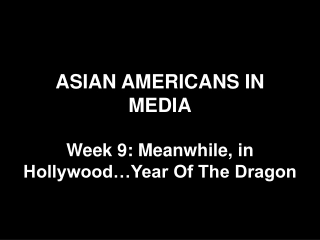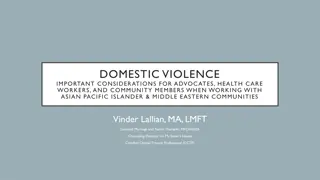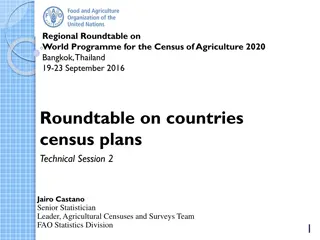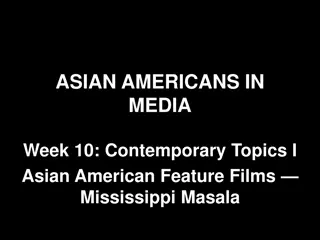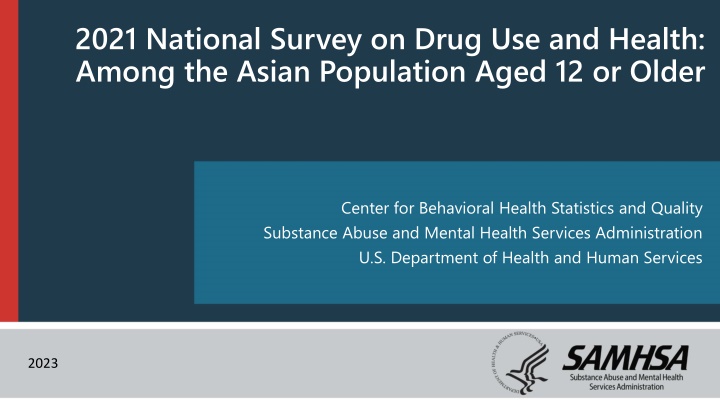
National Survey on Drug Use and Health Among Asian Population
Explore the findings of the 2021 National Survey on Drug Use and Health among the Asian population aged 12 or older. Learn about the scope, target population, and reasons data from 2021 should not be compared with previous years. Statistical testing and categorization of racial and ethnic groups are also discussed.
Download Presentation

Please find below an Image/Link to download the presentation.
The content on the website is provided AS IS for your information and personal use only. It may not be sold, licensed, or shared on other websites without obtaining consent from the author. If you encounter any issues during the download, it is possible that the publisher has removed the file from their server.
You are allowed to download the files provided on this website for personal or commercial use, subject to the condition that they are used lawfully. All files are the property of their respective owners.
The content on the website is provided AS IS for your information and personal use only. It may not be sold, licensed, or shared on other websites without obtaining consent from the author.
E N D
Presentation Transcript
2021 National Survey on Drug Use and Health: Among the Asian Population Aged 12 or Older Center for Behavioral Health Statistics and Quality Substance Abuse and Mental Health Services Administration U.S. Department of Health and Human Services 2023 1
NSDUH Scope and Target Population Conducted by the Federal Government since 1971 Comprehensive household interview survey of substance use, substance use disorders, mental health, and the receipt of treatment services for these disorders in the United States Produces estimates representative of the population at national and state levels Covers the civilian, noninstitutionalized population aged 12 or older in all 50 states and Washington, DC: Includes households, college dorms, homeless in shelters, civilians on military bases Excludes active military, long-term hospital residents, prison populations, homeless not in shelters NSDUH 2021 sample included 69,850 people 2
Data from 2021 should not be compared or pooled with data from prior years Why not? 1 Mode effect: Web data collection began in 2020. There were significant differences in estimates between web and in-person modes of data collection. Seasonal effect: There were systematic differences between two-quarter estimates from 2015 to 2019 and corresponding four-quarter estimates. Because 2020 data were mostly collected in only two quarters, these data cannot be compared with the full year of 2021 data. 2 Substance Use Disorder (SUD) definition changes: Starting in 2020, SUDs were defined according to criteria from the Diagnostic and Statistical Manual of Mental Disorders, 5th edition (DSM-5). Therefore, SUD estimates cannot be compared with 2019 or earlier. 3 3
About This Presentation The racial and ethnic groups discussed in this presentation are mutually exclusive. People who were of Hispanic or Latino ethnicity could be of any race but are not included in the estimates for any of the racial categories. Estimates for people who were not of Hispanic or Latino ethnicity are reported by race. People reporting two or more races and who were not of Hispanic or Latino ethnicity are noted as Multiracial in this presentation. People reporting their race as Black or African American are subsequently referred to as Black. People reporting their ethnicity as Hispanic or Latino are subsequently referred to as Hispanic. Statistical testing was performed for comparisons of estimates across age groups and among racial and ethnic groups according to procedures described in the 2021 Methodological Summary and Definitions report.1 For consistency with the typical criteria for statistical testing in NSDUH, age group differences were considered statistically significant at the .05 level of significance. For testing among racial and ethnic groups, a more conservative level of .01 was used for considering differences to be statistically significant. Statistically significant differences resulting from these testing procedures are described using terms such as higher, lower, more likely, or less likely. Statements use terms such as similar or the same when a difference was not statistically significant. When estimates are presented without reference to differences across groups, statistical significance is not implied. 1 See Section 3.2.3 in the following reference: Center for Behavioral Health Statistics and Quality. (2022). 2021 National Survey on Drug Use and Health (NSDUH): Methodological summary and definitions. https://www.samhsa.gov/data/report/2021-methodological-summary-and-definitions 4
Past Month Substance Use: Among Asian People Aged 12 or Older Rx = prescription. Note: The estimated numbers of current users of different substances are not mutually exclusive because people could have used more than one type of substance in the past month. 6
Past Month Alcohol Use, Binge Alcohol Use, and Heavy Alcohol Use: Among Asian People Aged 12 or Older Note: Binge Alcohol Use is defined as drinking five or more drinks (for males) or four or more drinks (for females) on the same occasion on at least 1 day in the past 30 days. Heavy Alcohol Use is defined as binge drinking on the same occasion on 5 or more days in the past 30 days; all heavy alcohol users are also binge alcohol users. 7
Binge Alcohol Use in the Past Month by Racial and Ethnic Groups: Among People Aged 12 or Older Binge drinking among Asian people was lower than among people in all other racial and ethnic groups except NHOPI * Low precision; no estimate reported. NH = Not Hispanic or Latino; AIAN = American Indian or Alaska Native; Black = Black or African American; Hispanic = Hispanic or Latino; NHOPI = Native Hawaiian or Other Pacific Islander. Note: Binge Alcohol Use is defined as drinking five or more drinks (for males) or four or more drinks (for females) on the same occasion on at least 1 day in the past 30 days. 8
Type of Tobacco Use and Nicotine Vaping: Among Asian People Aged 12 or Older Who Used Nicotine Products in the Past Month More than 75% of past month nicotine product users used tobacco products only 9
Past Month Nicotine Vaping: Among Asian People Aged 12 or Older The percentage of people who vaped nicotine was highest among Asian young adults aged 18 to 25 10
Past Year Illicit Drug Use: Among Asian People Aged 12 or Older Rx = prescription. Note: The estimated numbers of past year users of different illicit drugs are not mutually exclusive because people could have used more than one type of illicit drug in the past year. 12
Past Year Illicit Drug Use and Marijuana Use: Among Asian People Aged 12 or Older Among young adults aged 18 to 25, 24.7% used illicit drugs and 21.6% used marijuana in the past year 13
Illicit Drug Use in the Past Month by Racial and Ethnic Groups: Among People Aged 12 or Older Asian people were less likely to use illicit drugs than people in all other racial and ethnic groups NH = Not Hispanic or Latino; AIAN = American Indian or Alaska Native; Black = Black or African American; Hispanic = Hispanic or Latino; NHOPI = Native Hawaiian or Other Pacific Islander. 14
Marijuana Use in the Past Month by Racial and Ethnic Groups: Among People Aged 12 or Older Asian people were less likely to use marijuana than people in all other racial and ethnic groups NH = Not Hispanic or Latino; AIAN = American Indian or Alaska Native; Black = Black or African American; Hispanic = Hispanic or Latino; NHOPI = Native Hawaiian or Other Pacific Islander. 15
Past Year Opioid Misuse: Among Asian People Aged 12 or Older 16
Opioid Misuse in the Past Month by Racial and Ethnic Groups: Among People Aged 12 or Older No significant differences in prevalence of opioid misuse between racial and ethnic groups * Low precision; no estimate reported. NH = Not Hispanic or Latino; AIAN = American Indian or Alaska Native; Black = Black or African American; Hispanic = Hispanic or Latino; NHOPI = Native Hawaiian or Other Pacific Islander. 17
Past Year Substance Use Disorder (SUD): Among Asian People Aged 12 or Older Note: The estimated numbers of people with substance use disorders are not mutually exclusive because people could have use disorders for more than one substance. 1 Includes data from all past year users of marijuana, cocaine, heroin, hallucinogens, inhalants, methamphetamine, and prescription psychotherapeutic drugs (i.e., pain relievers, tranquilizers, stimulants, or sedatives). 2 Includes data from all past year users of the specific prescription drug. 19
Past Year Substance Use Disorder: Among Asian People Aged 12 or Older Asian young adults aged 18 to 25 were the most likely to have a past year substance use disorder * Low precision; no estimate reported. 1 Includes data from all past year users of marijuana, cocaine, heroin, hallucinogens, inhalants, methamphetamine, and prescription psychotherapeutic drugs (i.e., pain relievers, tranquilizers, stimulants, or sedatives). 20
Substance Use Disorder (SUD) in the Past Year by Racial and Ethnic Groups: Among People Aged 12 or Older Asian people were less likely to have an SUD than people from all other racial and ethnic groups NH = Not Hispanic or Latino; AIAN = American Indian or Alaska Native; Black = Black or African American; Hispanic = Hispanic or Latino; NHOPI = Native Hawaiian or Other Pacific Islander. 21
Major Depressive Episode: Among Adolescents Aged 12 to 17 22
Major Depressive Episode (MDE) in the Past Year by Racial and Ethnic Groups: Among Adolescents Aged 12 to 17 Asian adolescents were less likely to have MDE than Multiracial, Hispanic, and White adolescents * Low precision; no estimate reported. NH = Not Hispanic or Latino; AIAN = American Indian or Alaska Native; Black = Black or African American; Hispanic = Hispanic or Latino; NHOPI = Native Hawaiian or Other Pacific Islander. 23
Any or Serious Mental Illness: Among Adults Aged 18 or Older 24
Past Year Mental Illness: Among Asian Adults Aged 18 or Older The prevalence of mental illness was highest among Asian young adults aged 18 to 25 for both any mental illness and serious mental illness * Low precision; no estimate reported. 25
Any Mental Illness in the Past Year by Racial and Ethnic Groups: Among Adults Aged 18 or Older Asian adults were less likely to have a mental illness than Multiracial, White, Black, and Hispanic adults NH = Not Hispanic or Latino; AIAN = American Indian or Alaska Native; Black = Black or African American; Hispanic = Hispanic or Latino; NHOPI = Native Hawaiian or Other Pacific Islander. 26
Receipt of Mental Health Services by Racial and Ethnic Groups: Among Adults Aged 18 or Older with a Past Year Mental Illness Asian adults with mental illness were less likely to have received services than White, Multiracial, Black, and Hispanic adults * Low precision; no estimate reported. NH = Not Hispanic or Latino; AIAN = American Indian or Alaska Native; Black = Black or African American; Hispanic = Hispanic or Latino; NHOPI = Native Hawaiian or Other Pacific Islander. 27
Serious Thoughts of Suicide, Suicide Plans, and Suicide Attempts 28
Past Year Serious Thoughts of Suicide, Suicide Plans, or Suicide Attempts: Among Asian Adolescents Aged 12 to 17 11.2% of Asian adolescents had thoughts of suicide 4.4% made a suicide plan 2.9% attempted suicide Many Asian adolescents did not want to answer questions about suicide, which suggests that some Asian adolescents could have had these thoughts but did not feel comfortable disclosing that information 29
Past Year Serious Thoughts of Suicide, Suicide Plans, or Suicide Attempts: Among Asian Adults Aged 18 or Older Thoughts of suicide, suicide plans, and suicide attempts were highest among Asian young adults aged 18 to 25 * Low precision; no estimate reported. 30
Suicidality by Racial and Ethnic Groups: Among Adults Aged 18 or Older Few racial and ethnic differences were found for suicidality 31
Co-Occurring Substance Use Disorder and Mental Illness: Among Adults Aged 18 or Older 32
Co-Occurring Substance Use Disorder and Any Mental Illness: Among Asian Adults Aged 18 or Older 524,000 (3.5%) Asian adults aged 18 or older had co-occurring SUD and AMI 1 in 6 (35.5%) of all Asian young adults aged 18 to 25 had SUD or AMI AMI = any mental illness; SMI = serious mental illness; SUD = substance use disorder. 33
Past Year Substance Use by Mental Illness: Among Asian Adults Aged 18 or Older Asian adults with AMI in the past year were more likely to have used or misused these substances (except opioid misuse) than those without mental illness * Low precision; no estimate reported. AMI = any mental illness. + Difference between this estimate and the estimate for adults aged 18 or older without mental illness is statistically significant at the .05 level. 34



